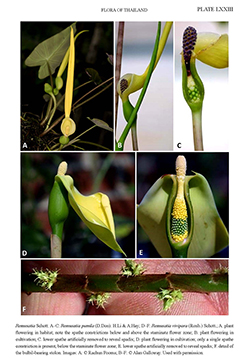e-Flora of Thailand
Volume 11 > Part 2 > Year 2012 > Page 265 > Araceae > Remusatia
1. Remusatia pumila (D.Don) H.Li & A.Hay
Acta Bot. Yunnan., Suppl. 5: 28. 1992.— Caladium pumilum D.Don, Prodr. Fl. Nepal.: 21. 1825.— Colocasia pumila (D.Don) Kunth, Enum. Pl. 3: 40. 1841.— Gonatanthus pumilus (D.Don) Engl. & Krause in Engl., Pflanzenr. IV, 23E (Heft 71): 19. 1920. Plate LXXIII: A–C.
Accepted Name : This is currently accepted.
Synonyms & Citations :
Description : Small to medium, slender, epiphytic or lithophytic, seasonally dormant herb to 25 cm. Stem a globose tuber 1–2.55 cm diam., epigeal, covered with the fibrous remains of petioles and cataphylls, often a few tubers together; stolons numerous, spreading, much branched, 10–20 cm by 1–3 mm; bulbils ellipsoid, 0.5 by 2 mm, barbs recurved, ca 1 mm. Leaves 3–4 together; petiole slender, 15–40 cm; petiolar sheath occupying lower ¼–⅓; leaf blade ovate to oblongovate peltate, 8–23.5 by 7–14.5 cm, acute or slightly acuminate, base shallowly cordate, sinus 5–45 mm wide; basal ribs well-developed; primary lateral veins 4–5 each side, radiating from petiole and pinnately from midrib of main lobe; secondary venation pinnate from primary veins; dull green on both surfaces, areas between primary veins often purple below and/or above. Inflorescences appearing when plants in leaf, usually one per tuber; peduncle 6–10 cm; spathe 14–22.5 cm long, with two constrictions, one between tube and spathe limb and another above the spadix; lower spathe globose, 1–1.5 by ca 1 cm, green; spathe limb 13–21 cm; the lower part of limb separated in two parts by a constriction; lower subglobose, 1.5–2.5 cm, opening to reveal staminate part of spadix, upper narrowly lanceolate apex long-acuminate, 11.5–21 cm by 6–15 mm, membranous, yellow or yellow-green on both surfaces, erect, elongate, fully opening only for a short time (less than 4 hours), then withering; spadix 2–2.5 cm, much shorter than the spathe; pistillate zone 5.5–7.5 by 3.5–4.5 mm, with 3–4 whorls of staminodes at top and 1–2 whorls at base, ovary globose-ellipsoid, green; stigma capitate, paler; sterile interstice slender, 4–5 mm, tapering upwards, covered with elongated synandrodes, yellow; staminate flower zone clavate, ca 10 by 4 mm, violet to purplish white; synandria 0.6 by 1 mm, violet to purplish white. Fruiting spathe ellipsoid, splitting to reveal globose berries ripening red.
Thailand : NORTHERN: Chiang Rai (type of Remusatia garrettii: Garrett 225, holotype -P, isotypes -BKF C K), Chiang Mai, Lampang, Tak; PENINSULAR: Phangnga.
Distribution : NE India, Nepal (type), Bhutan, SW China.
Ecology : Moist evergreen hill to lower montane forests as an epiphyte, or epilithic on granite and occasionally on limestone.
Vernacular : Bon priao (บอนเปรี้ยว)(Chiang Mai); bon pha (บอนผา)(Lampang).
Notes: Remusatia pumila is readily distinguished from R. vivipara by the spathe with two constrictions. Sterile material may be identified by the generally smaller stature, the muchbranched nature of the stolons, and the (usually) abaxially purple-stained leaf blade.

